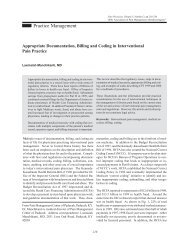ASIPP Practice Guidelines - Pain Physician
ASIPP Practice Guidelines - Pain Physician
ASIPP Practice Guidelines - Pain Physician
Create successful ePaper yourself
Turn your PDF publications into a flip-book with our unique Google optimized e-Paper software.
Manchikanti et al • <strong>ASIPP</strong> <strong>Practice</strong> <strong>Guidelines</strong><br />
67<br />
the patients in 20 trials (713). Many new indications and<br />
techniques have evolved for SCS over the last several years<br />
including dual lead systems, retrograde cannulation, and<br />
transacral stimulation for pelvic pain.<br />
Spinal cord stimulation is an invasive interventional surgical<br />
procedure. The difficulty of randomized clinical trials<br />
in such situations is well recognized. There were three<br />
prospective studies evaluating effectiveness of spinal cord<br />
stimulation in postlumbar laminectomy syndrome (711),<br />
reflex sympathetic dystrophy (695), and diabetic neuropathy<br />
(714). In addition, there have been numerous observational<br />
studies (691-694, 706-710, 712, 713). Based on the<br />
above reports the evaluation of the type and strength of<br />
efficacy evidence is level III - moderate. Level III - moderate<br />
evidence is defined as evidence obtained from welldesigned<br />
trials without randomization, single group prepost,<br />
cohort, time series, or matched case controlled studies.<br />
Implantable Intrathecal Drug Administration Systems<br />
Despite continued debate, chronic opioid therapy in the<br />
treatment of persistent pain of non cancer origin has gained<br />
broad acceptance (715-718), in addition to established<br />
chronic opioid therapy in cancer pain. The development<br />
of acceptable drug administration systems has been met<br />
with both enthusiasm (719) and controversy (720). Even<br />
though various guidelines have been proposed (721), much<br />
of the information is yet to come out or be absorbed about<br />
the long term effects of intrathecal opioid therapy. It appears<br />
that there is an increasingly large number of patients<br />
who have undergone intrathecal therapy for more than two<br />
years (722). Results indicating good to excellent outcome<br />
in nearly 70% of patient population which would have been<br />
considered quite refractory to standard types of management<br />
have been reported (721, 723-725).<br />
Willis and Doleys (715), in a retrospective evaluation of<br />
29 consecutive patients with a follow up duration of 31<br />
months reported an average 63% improvement in pain, 46%<br />
improvement in activity level, and 54% improvement in<br />
ease of performing activities. Other results were of Doleys<br />
et al (723), with 61% relief; Paice et al (726), also with<br />
61% relief, though in a large, retrospective, multicenter<br />
survey. In other studies, Tutak and Doleys (727) reported<br />
a good or excellent outcome in 78% of the patients, Kremes<br />
and Lanning (719) reported good or excellent outcome in<br />
81% of patients, and others (724, 725) at 70%.<br />
Other drugs also have been utilized in implantable systems.<br />
Hilten et al (728) studied intrathecal baclofen for<br />
the treatment of dystonia in patients with reflex sympathetic<br />
dystrophy. They performed a double-blind, randomized,<br />
controlled, crossover of bolus intrathecal injections<br />
of 25, 50, and 75 mg of baclofen in placebo. The results<br />
showed that in six women, bolus injections of 50 and 75<br />
mg of Baclofen resulted in complete or partial resolution<br />
of focal dystonia of the hands but little improvement in<br />
dystonia of the legs. During continuous therapy, three<br />
women regained normal hand function and two of these<br />
three women regained the ability to walk. In one woman<br />
who received continuous therapy, the pain and violent jerks<br />
disappeared and the dystonic posturing of the arm decreased.<br />
In two women, the spasms and restlessness of the<br />
legs decreased, without any change in the dystonia. They<br />
concluded that in some patients, the dystonia associated<br />
with reflex sympathetic dystrophy responded markedly to<br />
intrathecal baclofen. Even though this was a double-blind,<br />
randomized, controlled, crossover trial, it included only a<br />
total of seven patients; but this probably is the best evidence<br />
available for this type of therapy in a randomized<br />
controlled trial.<br />
Avellino and Loeser (729) also studied intrathecal baclofen<br />
for the treatment of intractable spasticity of the spine or<br />
brain etiology in a retrospective review of 62 consecutive<br />
adult patients who underwent placement of a programmable<br />
pump. They concluded that, intrathecal baclofen is an effective<br />
strategy for the relief of medically intractable spasticity<br />
of spine or brain etiology.<br />
Intrathecal drug delivery system is an invasive surgical<br />
procedure. Again, this is met with difficulties with evaluation<br />
in a randomized clinical trial considering the various<br />
difficulties of a randomized clinical trial in such a situation<br />
along with the presence of one double-blind randomized<br />
controlled crossover study for baclofen and an enormous<br />
amount of evidence from observational studies. In<br />
consideration of multitude of factors, it is determined that,<br />
the evaluation of type and strength of efficacy evidence<br />
for intrathecal implantable drug delivery systems is level<br />
III - moderate. Level III - moderate is defined as evidence<br />
obtained from well-designed trials without randomization,<br />
single group pre-post, cohort, time series, or matched case<br />
controlled studies.<br />
Complications<br />
The most common and worrisome complications of interventional<br />
techniques are two-fold. These include complications<br />
related to a technique of an interventional proce-<br />
<strong>Pain</strong> <strong>Physician</strong> Vol. 4, No. 1, 2001
















